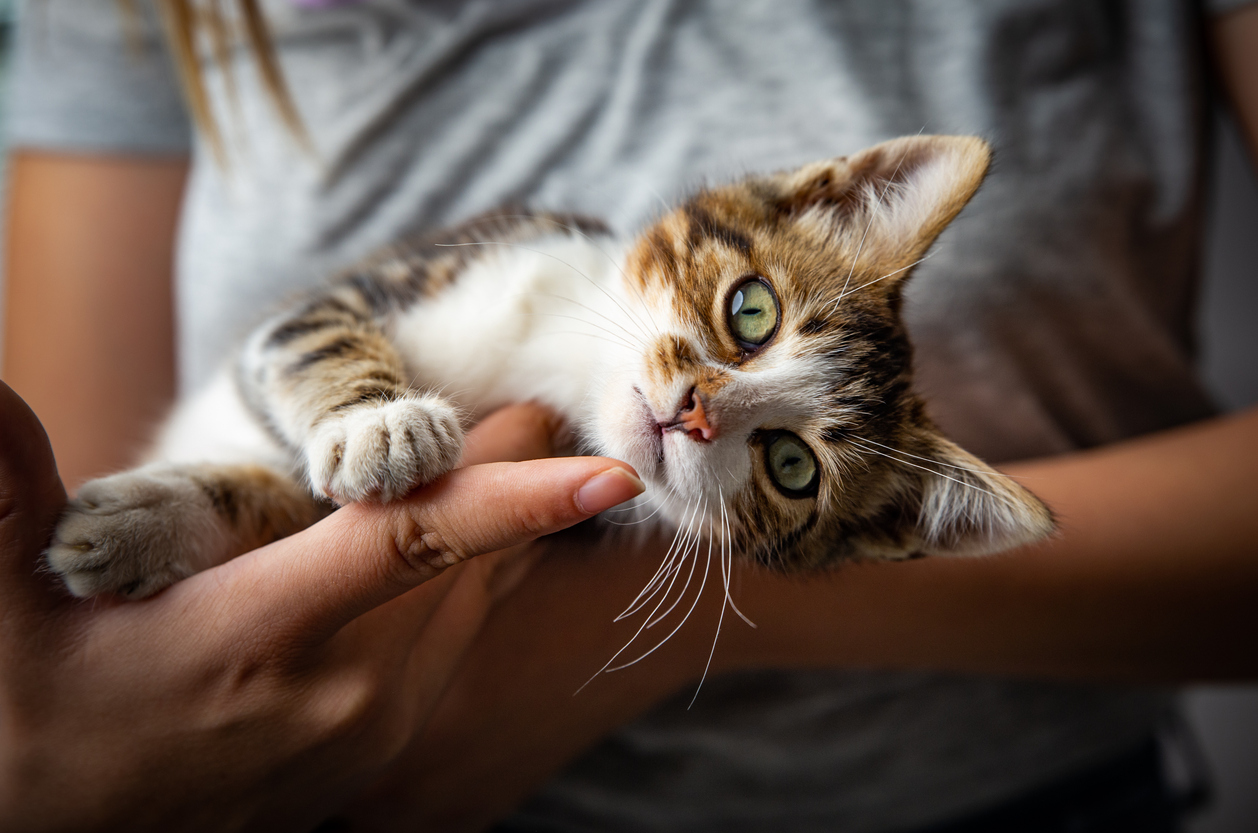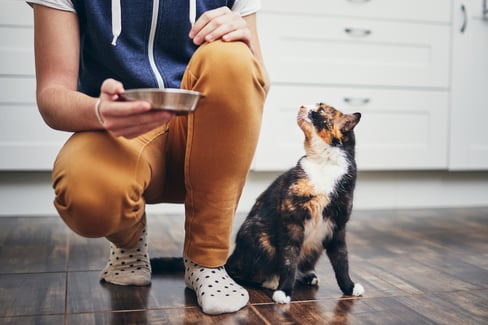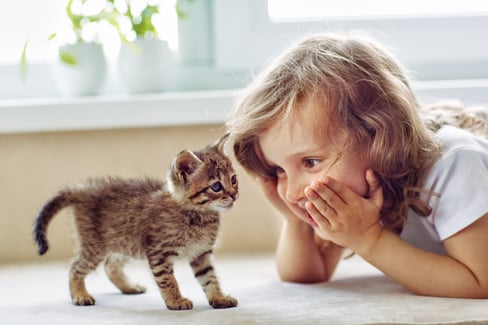Table of Contents
Kittens – our teeny tiny, oh-so-adorable balls of fluff. They’re almost as mischievous as they are adorable and they certainly make our lives better, as much trouble as they can get into!
And since we love them so much, we want to give them the best care possible, right from the start! That means knowing exactly what to expect before you even bring your new bundle of fluff home and how to take care of a kitten from the time they enter your world until they grow big and strong into adult felines.
In this post, we’ll cover the importance of kitten care, from giving them a bath to feeding them, and what you even need to buy for these special little bundles of fur to ensure they stay safe, healthy, and happy.
Importance of Kitten Care
The importance of kitten care is often underestimated by people who haven’t had one before or have only had adult felines. Kittens need specialized attention and care compared to their adult feline counterparts, and the importance of understanding exactly what goes into their needs and care in those first few months of life cannot be emphasized enough.
Kittens are born blind, deaf, and without teeth, but they grow up fast! The first three months are crucial for their development as they learn how to walk, eat, go to the bathroom, and socialize with other kitties and humans.
This is when they must be closely monitored and cared for by their humans for their own well-being and safety and help from mothers or other adult cats in their group who teach them the ropes can always be helpful, too.
How to Take Care of Kittens at Birth
The first few days after birth are critical for kittens. They need to be kept warm and well-fed. Newborn kittens have not yet developed the ability to regulate their own body temperature, so they are very susceptible to the cold.
In the first few weeks of life, kittens nurse frequently – every 2 to 3 hours for 45 minutes at a time for the first week of life – so their mother will keep them warm with her body heat and nurse them often.
Kittens should be kept with their mother in a quiet, safe, draft-free area until they are about 2 weeks old. This is when they start exploring and learning about the world around them. After 2 weeks, kittens can be introduced to other family members and pets.
The best way for humans to care for newborn kittens is by keeping them with their mothers until they are weaned (at around 9 to 10 weeks). This is often when a kitten can safely be rehomed away from its litter and is the most common time for kittens to enter your care.
How to Care for a Kitten
Now that we’ve touched on a few important points about caring for your new kitten and why it is important to know how to take care of a kitten in your home, let’s take a look at some of the milestones your kitten experiences in their first weeks and months of life.
The chart above shows the progression of kittens from birth to 8 weeks. As you can see, they go from tiny, vulnerable babies to more confident, playful kitties in a short time!
This chart outlines the period before kittens are ready to be adopted, so we’ll focus the next section on care and milestones when most kittens enter their furever home, after about 8 to 10 weeks.
8 Weeks Old
These kitties are typically just about ready to go to their new homes. There are plenty of things happening at this milestone worth noting.
Consult the table below for a quick guide to the 8-week-old kitten.
|
Kitten Development Milestone |
What’s Happening |
|
Average Weight |
Anywhere from 2 pounds and up, depending on the breed. |
|
Socialization |
Begin playing with them using age-appropriate toys in short bursts. Ensure you spend plenty of time showing your little furball love at this stage to ensure bonding. |
|
Feeding |
Eating solid foods rather than formula or milk two to three times per day. |
|
Health & Medical |
Able to undergo spaying or neutering. |
9 to 12 Weeks
At nine weeks, you may start to feel like your baby is pretty grown up! Their adult eye colour should be obvious, and they're exhibiting adult cat behaviour and body language.
Consult the table below for a quick guide to the other things happening with your 9 to 12-week- old kitten.
|
Kitten Development Milestone |
What’s Happening |
|
Average Weight |
2 ½ pounds or more, depending on their breed and how well they feed. |
|
Socialization |
Kitties should be playful and show adult cat-like behaviours when it comes to playing. Spending 30 minutes at a time playing with them and exposing them to new people and things is crucial at this age. |
|
Feeding |
Kitties should eat solid kitten food 2 to 3 times per day. |
|
Health & Medical |
Ensure your kitten is checked by the vet and given their first core vaccine, the feline viral rhinotracheitis, calicivirus, panleukopenia, or FVRCP. |
3 to 6 Months
As much as your kitty has already grown, this next growth stage is equally important to their health and behaviour. A lot happens during this period, so knowing what to expect is definitely important for your kitten’s wellbeing.
Consult the table below for a quick guide to your 3 to 6-month-old kitten.
|
Kitten Development Milestone |
What’s Happening |
|
Average Weight |
Anywhere between 4 and 6 pounds on average. |
|
Socialization |
Their personality is well developed, and your kitten is just brave enough to put different items in its mouth, approach other animals, and try new and exciting things (hello toilet paper!) |
|
Feeding |
With their baby teeth falling out during this time, your kitty is ready to chow down on more hard or solid foods like dry kibble. |
|
Health & Medical |
Two booster doses of the FVRCP vaccine are administered in this window, along with a rabies shot. |
1 Year
Happy birthday, little kitty! Or, should we say, not so kitten anymore! One year marks your kitten’s transition from a little one to a fully grown adult. And while every breed is unique, this is generally when you can say you no longer have a kitten in the house.
Consult the table below for a quick guide to what to expect by your kitten’s first birthday!
|
Kitten Development Milestone |
What’s Happening |
|
Average Weight |
Full sized for their breed, anywhere from 8 pounds and up. |
|
Socialization |
While these cats are not kittens anymore, their behaviour is more akin to that of a wily teenager! They show plenty of energy and may still be figuring out the world around them, so nurturing their growth through play, and even training is essential. |
|
Feeding |
At the one-year appointment, your vet can also suggest how to transition from kitten food to adult food gradually. Introducing a new food over a period of 7 to 10 days is best, and incorporating a mix of kitten and adult food during this transition is usually recommended. |
|
Health & Medical |
Your vet will want to check on your one-year-old’s teeth and body condition and ensure they are up to date on any vaccine boosters. This will also likely be when they transition your kitty to a once-a-year checkup schedule rather than every few months as they do earlier on in life. |
Kitten Care 101 Essentials
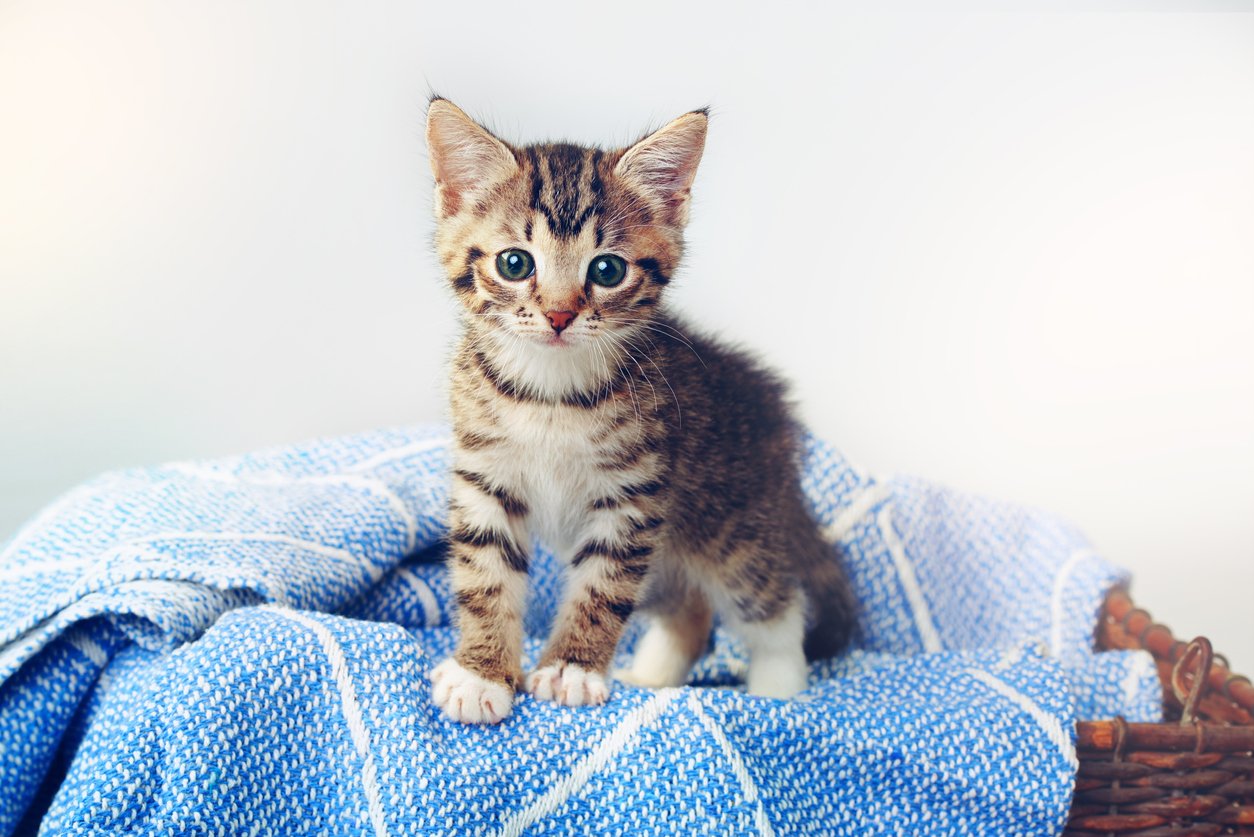
Worried about having the right stuff in your home for a kitten? Not sure what to ‘Add to Cart’? Not to worry – we’ve got a full breakdown that will not only give you a shopping list to take to the pet store but the tips and information you need to make the right choices, too.
Litter Box
You know your kitty needs a place to do their business. That’s easy enough – but you also need to make sure you have the right tools to take care of their business safely and sanitarily.
Alongside a good litter box, make sure you also have the following on hand for kitten care:
- Cat litter
- A mat or tray to set the litter box on
- Scooper tool
- Cleaning supplies
In terms of selecting an appropriate place for your kitty to do their business, kittens avoid enclosed litter boxes because they are dark, smelly, and unpleasant. It is more likely that cats will eliminate outside the box due to these qualities. Opt for an open, low-sided option instead.
You should also consider unscented and low-dust litters. Fragrances and dusty litter can offend cats and cause them to avoid the litter box or develop health problems.
Finally, keep in mind that a clean litter box is crucial because your kitten will avoid using a messy and smelly one, which can cause accidents at home. Wash your litter box with hot soapy water once a week and once a month with diluted bleach if you want less odour!
Bowls
Choose food and water bowls that won't tip over too easily. If your kitten is sensitive to plastic, choose a more durable material, such as stainless steel or ceramic, that can be easily cleaned. Cat fountains are also a great option, especially if you notice that your cat isn’t drinking as much water as they could be. Many cats love to drink from running water sources, like faucets or the hose, so consider getting a fountain if your feisty feline prefers running water.
Keep your kitten's food and water bowls clean and fresh by washing them daily (or changing the cat fountain’s filter regularly). It’s important to make sure your cat has access to fresh, clean water at all times.
Kitten Food and Supplements
A kitten can eat wet food, dry food, or both! A variety of flavours and textures will help them grow into adventurous eaters as they get older, which will be helpful if they need to switch foods later on.
As your kitten grows, their food needs to change and adapt, but generally, they go from eating smaller portions more frequently to larger, less frequent meals as they age.
Among the essential nutritional requirements of kitten care and feeding are:
- Water
- Minerals
- Vitamins
- Protein
- Fat
The best kitten food is approved by The Association of American Feed Control Officials (AAFCO) and is the best way to ensure that kittens get all of these nutrients.
A cat joint supplement is something else you want to add to your to-buy list. This helps support your kitten’s growth and helps ensure their joints become healthy and strong. Choose a high-quality, easy-to-feed supplement like Integricare TRI-ACTA for pets for the best results for your kitten. It contains chondroitin and glucosamine for cats, as well as MSM. These ingredients help ensure your kitten will be bouncy and playful for years to come. TRI-ACTA for pets has no fillers, so the servings are very small and easy to administer (1 gram). A kitten would only require about ¼ of a serving (¼ gram) per day.
TRI-ACTA for Pets
A proactive approach for developing and younger adult pets to maintain optimal joint health mobility, minimize inflammation and fend off age-related ailments.
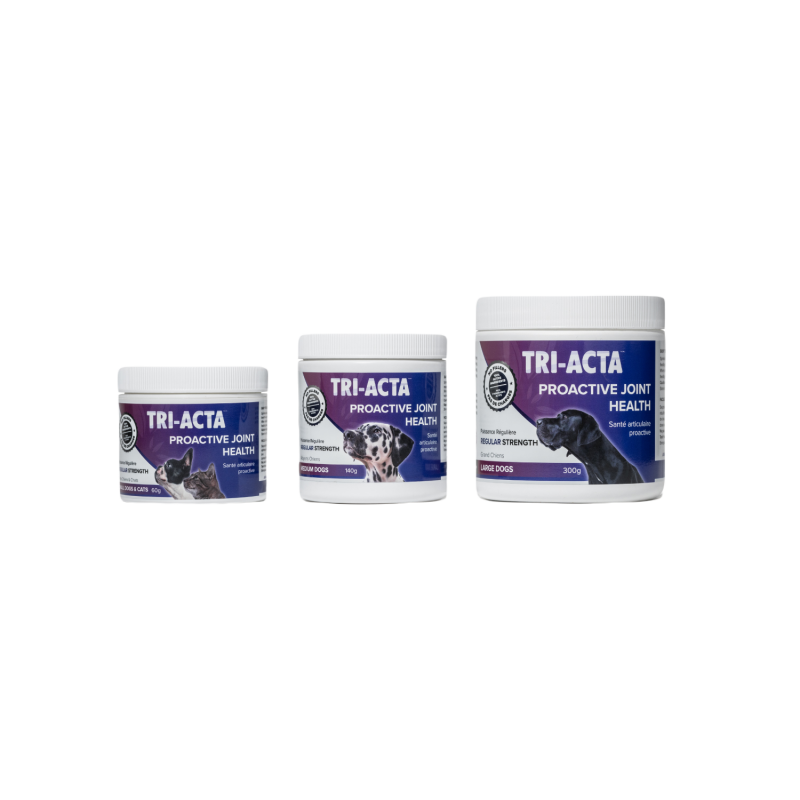
ID Tags
Your kitty may not be spending too much time outside yet, but they are slippery little guys and can get out of sight faster than we’d all like to admit. In fact, 1 in 3 pets will become lost in their lifetime, so ensuring they are properly microchipped and tagged is essential. Your vet can implant a microchip, which is usually placed in the soft tissue between your kitten’s shoulder blades. If your kitten is lost, any vet or animal control organization can scan your kitten and get access to your information, which is stored on the chip so that you can be contacted.
It’s also a good idea to pick up some ID tags and ensure they are up to date with your information so your kitty can be more easily located if they are lost.
On your kitten's ID tag, you should try to fit the following information:
- Your kitten’s name
- Your phone number
- Your address
Scratching Post
Make sure your cat has a place to scratch when you get them home! Contrary to common belief, cats don't sharpen their claws with scratching posts, but they actually use them to exercise, stretch out, clean away dead skin cells, and mark their territory.
Here are a few kitten care tips for getting them comfortable with using a scratching post:
- It is important to get a scratching post right away to help train your kitten early and keep them from clawing furniture.
- Engage your cat in interactive play near the post to entice them.
- Scratching posts should be sturdy and tall enough so your kitten can stretch out fully.
- Put the posts near the cat's sleeping area, not in the basement. Cats often scratch when they wake up from a nap, so place them near that area.
- You need to reward the cat every time they use the post. Keep tasty food treats nearby and give one to the cat whenever you see them scratching.
Cat Carrier
To keep your kitten safe and secure, you'll need to transport them in a cat carrier. Travelling can be a stressful experience for kittens, so make sure their carrier is spacious and well-ventilated and that they are as comfortable as pawsible during their journey.
Your cat should be able to stand, sit, and turn around while in its carrier. Generally, the size of the carrier should be one and a half times the size of your cat. Your cat can slide from side to side if the carrier is too large. You can also line the bottom of the carrier with a towel from home to give them a familiar scent and a bit more padding and comfort.
Cat Bed
A comfortable cat bed makes for a cozy place to rest after exploring and romping around their new home, and cats spend a great deal of time in their beds. There are options on the market for every kind of pawticular taste, but the bottom line is they want a quiet, draft-free, comfortable environment to call their own.
For the best kitten care, keep the following in mind when choosing bedding:
- The size of the bed: Make sure your kitten’s bed is big enough for them to move around comfortably but not so big they don’t feel cozy. Kitten beds often need to be replaced as your cat grows.
- Your kitten’s comfort: It isn't necessary for your cat to sleep in the lap of luxury, but a comfortable bed is beneficial. A cat that isn't comfortable enough will choose to sleep elsewhere, such as on your bed or in the laundry basket where you may not want them!
- Washability: Cats are particular creatures, so ensure their bedding stays clean by washing it regularly. This will reduce the spread of bacteria and reduce odours. Beds with removable covers are a great choice for this reason!
6 Vet Approved Kitten Care Tips
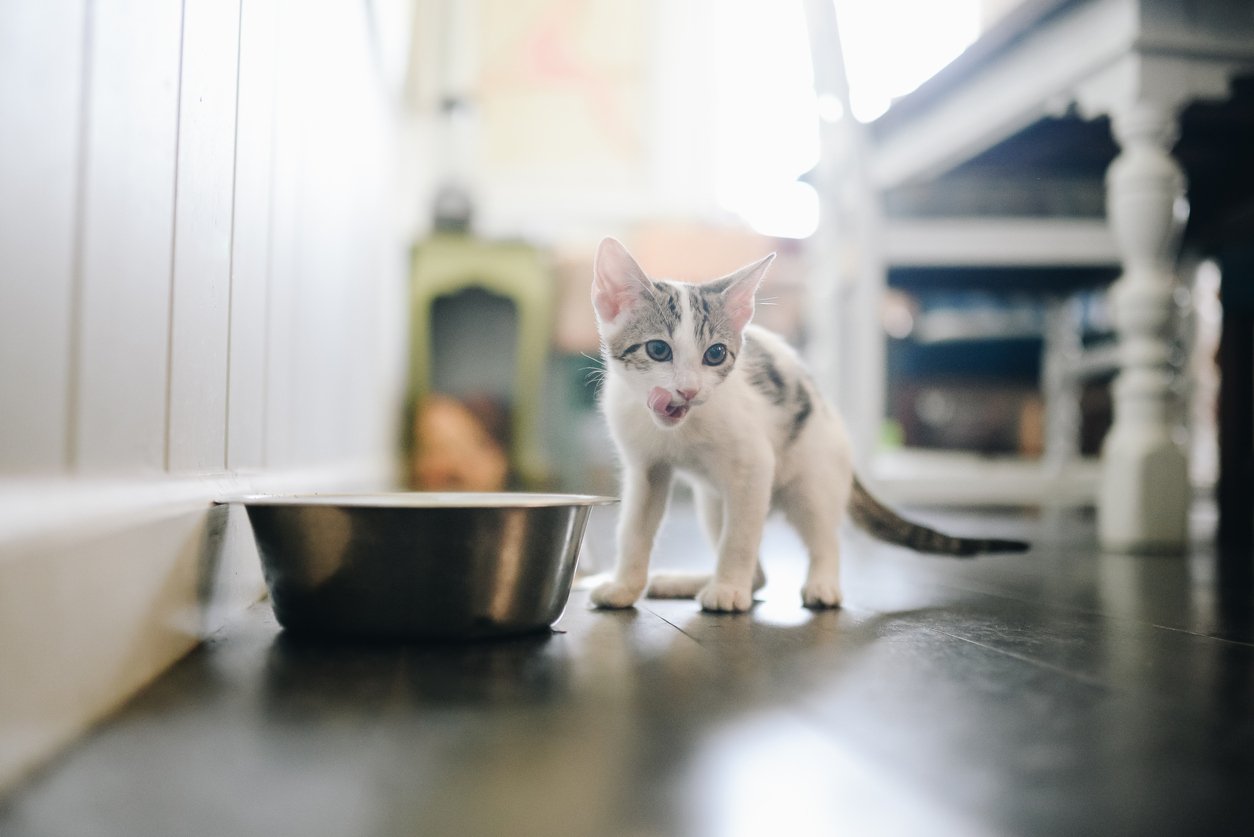
What do experts have to say about bringing your kitten home? Let’s get into some of the professionally approved tips for making sure your kitten’s transition into your home is smooth and painless.
Tip #1: Get Your Home Ready
There are a few things you need to do before bringing home your new kitten. First, ensure that your home is safe for a new kitten by ensuring there are no poisonous plants or chemicals in the area where they will be spending most of their time. Also, ensure that there are no electrical wires or cords that could hurt them.
Finally, ensure all necessary supplies are available before bringing them into their new environment!
We already talked about a list of things to buy for proper kitten care, but here’s a quick checklist to keep handy when you are shopping:
- Litterbox
- Bed
- Scratching Post
- Toys
- Cat carrier
- Kitten food
- Brushes
- Treats
- Food and water bowl(s)
Tip #2: Prepare the Family
If you're planning on bringing home a kitten, make sure everyone in the family is on board. Allowing children to pick out their own kitten can be a fun bonding experience and teach them responsibility. But keep in mind that kittens are high-energy, curious creatures who need constant attention.
Here are some good guidelines for children and families participating in kitten care that will improve the experience for everyone in your home:
- Teach your children how to handle and pet a cat properly. This includes learning to read basic body language. That way, they will know to stay away when your cat's ears are back, their tail is twitching, or they let out a hiss or growl.
- Before bringing your new feline friend home, talk with everyone in your household about what they expect from having a cat around. Make sure everyone understands the responsibilities of having a new kitten to care for.
- Spend time deciding who will care for various cat tasks and chores. For example, young children may not be able to clean the litter box, but they can help in the process of training your kitty.
- If you have another cat in the home, keep your new cat in a separate area for a few days before gradually introducing them to one another. Provide the new kitten with a litter box, toys, water, beds, and scratching posts. A spare bedroom or bathroom works great.
Tip #3: Be Ready for Bathtime
While it may seem daunting, bathing your kitty is one of the most important things you should get your kitten used to when they are young. Bath time is a great way to bond with your kitten, but it's also important for their cat health. Even if you don't plan on having your kitten outside much, they should get used to being bathed at least once a month or even bi-weekly (more often if they're outdoor cats).
When you’re preparing your kitten care kit, don’t forget these bathtime essentials:
- Towels
- Warm water
- Gentle, fragrance-free baby soap
- Treats to reward them after the bath is done
Once you have your supplies assembled, follow these kitten care 101 steps for bathing:
- Make sure the room you’re bathing them in is warm. If you have a heater, that can help warm up a space like your kitchen quickly. You can also run the shower for a few minutes before the bath to steam up and warm the bathroom.
- Wear clothes you don’t mind getting wet in, and long sleeves are generally not a good idea for bath time!
- Run your kitten a warm bath, but the water should not be hot. It should be a similar temperature to that of a baby’s bath!
- Wash your kitten thoroughly by gently rubbing the soap and water into their fur. Avoid their eyes and the insides of their ears.
- You can hold the kitten gently by their scruff (the skin at the back of their neck) like their mother would provide some calm. Just be sure to support them and be gentle during this process.
- Grab your towels and carefully dry them off. Warming the towels in the dryer first is a great way to give them snuggly comfort and keep them warm, especially for very young kittens.
Tip #4: Brush Up on Kitty Nutrition
One of the most important things you can do to keep your kitten healthy is to ensure they eat a proper diet. Kittens need high-quality food that is appropriate for their age and life stage, so it’s important to consult with your veterinarian before choosing a brand or type of food.
In general, some key components of kitty nutrition are necessary for good growth and development, including those outlined below in the table.
|
Kitten Nutrition |
Why It Matters |
|
Water |
Staying hydrated is key to overall cat health, and keeping plenty of fresh water available alongside food is essential for your kitten’s well-being. |
|
Protein |
As the building blocks of cells, tissues, organs, enzymes, hormones, and antibodies, proteins play a vital role in growth, maintenance, reproduction, and repair. |
|
Amino Acids |
Amino acids are the building blocks for protein. For cats, the amino acid taurine is particularly important in preventing eye and heart disease and reproducing, growing, and surviving as a fetus. |
|
Fats |
Cats need a wide range of fats, including essential fatty acids like Omega-3s to help with everything from supplying energy to healing inflammation. |
|
Carbohydrates |
Your cat's body needs carbohydrates to maintain its tissues, instigate digestion, and even reproduce! |
|
Vitamins and Minerals |
To function normally, cats need vitamins and minerals. Since most vitamins cannot be synthesized in the body, they must be obtained from their diet. |
Adding a cat supplement is also a good idea. Supplements can balance nutritional deficits and add to their diet with ingredients that support their growth and development. Ingredients like glucosamine and chondroitin are ideal for joint health support as these active little creatures grow bigger and stronger. That way, their joints can be protected from problems like arthritis down the road, and they can enjoy an active lifestyle for years to come.
A supplement like Integricare’s TRI-ACTA for pets is appropriate for kittens to start with, and as they age and their needs change, you can switch them to our sister product, TRI-ACTA H.A. for pets, with the inclusion of hyaluronic acid. Both formulas offer two types of glucosamine for maximum joint health benefit to your kitten.
TRI-ACTA H.A. for Pets
Our maximum strength formula is optimally designed to accelerate the formation of cartilage, minimize inflammation, expedite the healing process, and improve joint conditions.

Tip #5: Get Trained
You may have heard the saying, you can’t teach an old dog new tricks, but what about our feline friends? While it may not seem obvious, cats can be taught how to do (or not to do) plenty of things!
Examples of training tasks you can add to their kitten care:
- Using the litter box
- Going to their bed
- Not scratching furniture or other inappropriate objects
- Not biting or scratching people
- Tricks like rolling over
The trick to getting your new kitten to learn these things? Keep sessions short, sweet, and full of treats! And when your kitty loses interest, it’s time to move on. Just be sure to keep these sessions regularly so your kitten comes to expect them as part of their routine. That way, they will be ready to learn and play for years to come!
Tip #6: Don’t Forget Playtime
Playtime is not only a ton of fun for you and your kitty but also an important part of a kitten’s life. It helps them learn how to interact with people and other cats and build physical strength and agility. While some toys are made purely for entertainment purposes, others are designed for kittens to practice their hunting skills or work on balance and agility.
Some ideas for toys and games to try for kitten care and play include:
- Fishing rod-style toys
- Pouncing toys
- Interactive games and toys, such as roller balls
- Climbing and hiding toys and structures
- Teething toys like kitten-specific dental chews
- Scratching posts, mats, and toys
Cat parents should aim to engage their cats in about 20-30 minutes of playtime per day, spread out over several 10–15 minute sessions.
Wrapping Up

It’s a lot to take in how to take care of a kitten, we know! But by implementing some simple things you can do now to make sure your kitten grows up healthy and happy.
And one thing you don’t want to leave off the list? A cat joint care supplement like Integricare’s TRI-ACTA for pets. This product is 100% active ingredients designed to support their growth and joints as they pounce from one toy to the next for years to come.
TRI-ACTA for Pets
A proactive approach for developing and younger adult pets to maintain optimal joint health mobility, minimize inflammation and fend off age-related ailments.

Find out where to buy kitten care joint supplements from Integricare, and be sure to check out our other pet care tips and tricks on the blog.
Newsletter Signup
Subscribe to our newsletter to receive the latest news and exclusive offers.
.jpg?height=2000&name=Cliick_Integricare-DISPLAY-REVISEDV2%20(1).jpg)
Proactive & Therapeutic Joint Supplements
When given daily, Integricare joint supplements recover bone and joint injuries faster and help prevent mobility injuries from happening in the first place.

